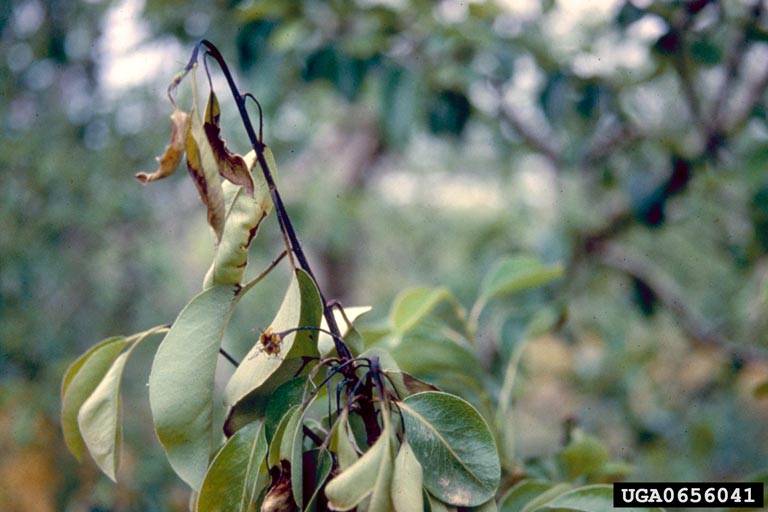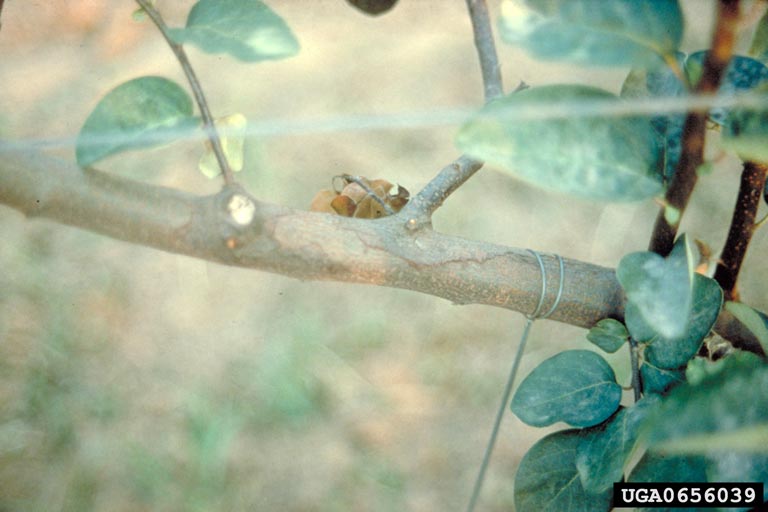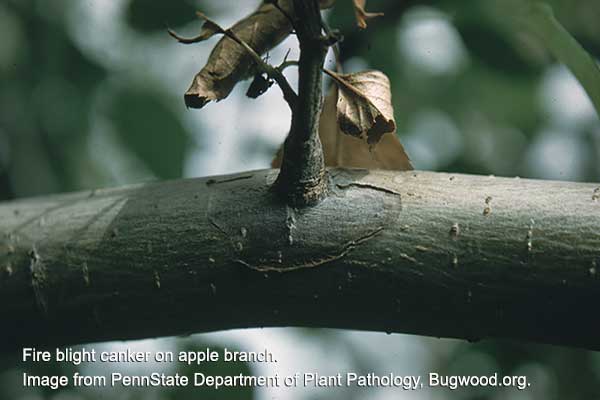How are we doing?
The Hort Update team strives to provide horticulture professionals with timely, relevant information from research-based sources. Complete a short survey and let us know how we can make Hort Update even better. Your feedback is greatly appreciated! Survey
| Serious Concerns | Major Symptom |
|---|---|
| 1. Fire blight |
Complete annual pruning before blooming begins; prune only to remove infected branches in spring; streptomycin applications |
| 2. April 1st growing degree days (GGD) | Lincoln Airport 3/31/22 - 1 GGD, Understanding Growing Degree Days |
| 3. Continuing drought | Ongoing drought for much of Nebraska (add drought map image) |
| 4. Ornamental grass fire hazard | Cut or mow grasses to reduce fire risk |
| Timely Topics | |
| 5. Fruit trees and cold temperatures | Stage of flower development determines injury potential; even apparently undamaged flowers may mask injury |
| 6. Stop pruning oaks | Avoid pruning between April 15th and November 15th |
| 7. Soil temperatures and timing of turf applications for DIY clientele | Publications to make clientele recommendations easy |
| 8. Avoid mulch volcanos | Apply mulch in a flat layer; keep away from tree bark |
| 9. Fertilizer & pest control products | Product costs, supply chain issues and worker shortages |
1. Fire blightComplete annual pruning before blooming begins; prune only to remove infected branches in spring; streptomycin applications
Fire blight is a common and destructive bacterial disease of plants in the rose family, including apple, pear and crabapple. It’s one of the most serious diseases of apple and pear, both fruiting types and ornamentals, but also affects quince, chokeberry, cotoneaster, crabapple, hawthorn, raspberry, rose and spirea. Symptoms include dead branches, water-soaked blossoms, light brown to blackened leaves, discolored bark, black "shepherd's crook" twigs, and dried fruits. It can kill branches and entire plants.
It’s caused by the bacteria Erwinia amylovora, which lives from one season to the next in cankers (dead sections of bark killed by the disease) on infected twigs, branches, or the main trunk. In spring bacteria begin multiplying rapidly and ooze to the surface of previous year’s cankers through cracks or natural openings as a clear, milky or amber-colored liquid. Then the bacteria are dispersed to new hosts by wind, rain, and insects.
 Infection & Symptoms
Infection & Symptoms
The amount and length of cool, rainy spring weather greatly influences how much fire blight we see each year. Moisture is necessary for the bacteria to survive and initiate infection, along with moderate temperatures of 60 to 75 F. Heavy infections occur when soil moisture is high, bud and shoot growth is rapid, and rainy periods are prolonged. Infection of blossoms frequently happens first, after insects bring the bacteria into the flowers. Infected flowers wilt, turn brown and die. (Image left - Shoot of 'Santa Maria' pear showing typical shepherd's crook shoot death symptoms. Image by P.G. Psallidas, Benaki Institute, Athens, Bugwood.org.)
Aside from killing flowers, fire blight attacks leaves, twigs, branches, the main trunk and fruits. Usually infected leaves are killed entirely, but occasionally only a portion will show infection. Affected portions turn various shades of brown and die. Typically, leaves killed by fire blight remain attached to the twigs for long periods. Dead branches often develop a characteristic shepherd’s-crook hook at the tip and look like they have been scorched by fire. Apple leaves and shoots turn a rusty-brown color, while infected pear leaves and shoots turn black.
Infection of large branches and the main trunk occurs through natural openings and wounds like hail damage or pruning cuts. Branch cankers are often on the underside of the branch. At first the cankers are light brown in color as they age the bark cracks and the canker surface becomes sunken. They may continue to enlarge until the branch or trunk is girdled, then everything beyond the girdled point dies.
 Control
Control
In susceptible trees, fire blight is difficult to control but infections can be reduced through a management strategy utilizing 1) fertilizer reduction, 2) sanitation, 3) spraying and 4) planting resistant varieties.(Image right - Fire blight shoot death on cotoneaster. Image by R. Grimm, Bugwood.org.)
Rapidly growing twigs, resulting from excessive fertility or heavy pruning, are extremely susceptible to fire blight. Avoid excessive twig growth by reducing the amount of nitrogen fertilizer applied beneath and around susceptible plants. Adjust nitrogen applications as needed so apple trees produce no more than 10 to 12 inches of new terminal growth each year; 6 to 8 inches for pear trees.
Since fire blight bacteria overwinter in cankers and small twigs, prune out and destroy infected growth during the dormant season. Removing all the dead branches is fine, but avoid extra heavy pruning that will cause the tree to initiate easily-infected sucker growth. Pruning before new growth begins is a good control practice.
Ideally major fruit tree pruning for size and structure was completed in March. Now, as trees begin to bloom in April, pruning should only be done to remove branches infected with fireblight. When removing a diseased branch the cut should be made 12 to 15 inches below any visible signs of the disease. Where a main branch is diseased, cut back to a strong, horizontal, outward-growing branch. To avoid spreading the disease when pruning during active growth, dip or spray pruning tools with a 10 percent bleach solution, made by mixing 1-part bleach with 9-parts water, between each cut. Dry and oil tools after use to prevent rust.
 Streptomycin application can kill the bacteria before they enter the tree. Follow label directions for application rates. Generally applications should be made when 60 to 75° F temperatures and wet weather occurs during bloom. Streptomycin applications should begin when 25% of flowers are open, and be repeated at 4-5 day intervals until petal fall. To reduce risk of antibiotic resistance developing 1) use the recommended labeled rate, 2) make no more than 3-4 applications per season, 3) do not use streptomycin after symptoms have developed and 4) do not use streptomycin for shoot blight or canker control. Streptomycin can also be used as a rescue treatment following a severe weather event, such as hail or high winds.
Streptomycin application can kill the bacteria before they enter the tree. Follow label directions for application rates. Generally applications should be made when 60 to 75° F temperatures and wet weather occurs during bloom. Streptomycin applications should begin when 25% of flowers are open, and be repeated at 4-5 day intervals until petal fall. To reduce risk of antibiotic resistance developing 1) use the recommended labeled rate, 2) make no more than 3-4 applications per season, 3) do not use streptomycin after symptoms have developed and 4) do not use streptomycin for shoot blight or canker control. Streptomycin can also be used as a rescue treatment following a severe weather event, such as hail or high winds.
Planting resistant apple and pear varieties is highly recommended to reduce fire blight infections. Refer to the following publications for lists of susceptible and resistant apple and pear cultivars. .(Image left - Fire blight stem canker. Image by P.G. Psallidas, Benaki Institute, Athens, Bugwood.org.)
Fire Blight of Apples and Pears, Ohio State University
Fruit Spray Schedules for the Homeowner, University of Missouri Extension
Midwest Fruit Pest Management Guide, 2021-2022
3. Continuing droughtOngoing drought for much of Nebraska
 Conditions remain dry and time will tell how much dessication injury will occur on plants. When injury shows up, remind clients to wait to prune damaged plant tissue until about June 1. Waiting allows new growth to occur if buds are still viable. If no new growth occurs on evergreens by June 1, and the damage is severe enough the plant has to be pruned back beyond where there is green foliage, evergreens will not regenerate new growth from this point. It would be best to replace the plant.
Conditions remain dry and time will tell how much dessication injury will occur on plants. When injury shows up, remind clients to wait to prune damaged plant tissue until about June 1. Waiting allows new growth to occur if buds are still viable. If no new growth occurs on evergreens by June 1, and the damage is severe enough the plant has to be pruned back beyond where there is green foliage, evergreens will not regenerate new growth from this point. It would be best to replace the plant.
Questions about watering continue. While most damage has likely already occurred, the benefit of watering dry soils in winter or early spring is moisture will be available as soon as soils are warm enough for root function. This could help prevent further damage. Irrigation needs to be done with hoses, early in the day, and avoid puddles; especially with winter watering.
Take this opportunity to remind homeowners correct watering during summer and fall is most important. While winter watering can provide some benefit, correct watering during the growing season is far more critical in reducing winter injury. During the growing season and well into fall, plant soils are best kept uniformly moist, but not saturated. Plants under- or overwatered during the growing season are at higher risk of winter injury. Overwatering leads to weakened roots that do not effectively take up moisture. The plant suffers dessication injury even though the cause is overwatering.
With the fertilization season soon here, it is recommended not to fertilize plants showing symptoms of drought stress. Unless plants can be irrigated on a regular basis or rainfall occurs, avoid fertilization. Plants cannot take up nutrients in fertilizer without adequate water. Some fertilizers can damage roots and scorch leaves if water is lacking.
4. Ornamental grass fire hazardCut or mow grasses to reduce fire risk
The dry, dead tops of ornamental grasses can be a fire hazard; especially during drought. They create tinder and fuel for a carelessly discarded cigarette or possibly an electrical short. They ignite easily, burn rapidly and flames can reach quite high. Tall grass will quickly carry fire to a building. It would be wise to cut these back sooner than later this year. Cut or mow grasses low around the house, garage, outbuildings, decks, firewood piles, propane tanks, shrubs, and specimen trees with low-growing branches.
5. Fruit trees and cold temperaturesStage of flower development determines injury potential; even apparently undamaged flowers may mask injury
Recent cold temperatures have some wondering if fruit tree buds were injured. The stage of flower bud development when cold temperatures occur determines injury susceptibility. Fully dormant flower buds tolerate very cold temperatures. When damaged, it’s usually because warm winter temperatures caused flower buds to lose dormancy. For example, if apple flower buds break dormancy but show no color, 10 percent are killed by 15°F. and 90 percent by 2°. If apple flower buds show a bit of green color, 10 percent are killed by 18° and 90 percent by 10°. On flower buds showing any pink color, 10 percent are killed by 28° and 90 percent by 24°. With above average temperatures this winter, along with some very cold nights, the likelihood of damage is present. The entire fruit crop may not be lost, just a portion which could be beneficial in limiting overproduction that leads to alternate year bearing.
Damage or death from cold temperatures can be assessed by slicing open buds to look for a dark spot at the ovary, which is at the bottom of the bud. Ovary death can occur even in healthy looking buds or open flowers, therefore blooming does no necessarily mean that ovaries are undamaged.
Critical Spring Temperatures for Tree Fruit Bud Development Stages, Michigan State University Extension
Assessing frost and freeze damage to flowers and buds of fruit tree, Michigan State University Extension
6. Stop pruning oaksAvoid pruning between April 15th and November 15th
Now is the time to pause pruning oak trees. They are susceptible to a wilt disease vectored by an insect that is attracted to fresh cuts. Pruning should be avoided from April 15th to November 15th.
Questions have recently been raised about the recommendation to use wound dressings on oak trees to help prevent oak wilt; because with most pruning wound dressings/tree paints are not recommended as they tend to do more harm than good.
Oak wilt is thus far very rare in the state of Nebraska and only known to be on the Iowa/ Nebraska border. As for pruning oaks, according to Michigan State Extension, ONLY oak trees that must be pruned AFTER APRIL 15, for reasons of storm damage or otherwise, should be immediately treated with a tree wound dressing or latex-based paint to seal the wound. It is very important that fresh wounds be treated immediately because the insects that carry spores of the pathogen are often attracted to these wounds within a very short time.
Oak Wilt, Iowa State University Extension and Outreach
7. Soil temperatures and timing of turf applications for DIY clientelePublications to make clientele recommendations easy
Lawn care DIY’ers have the advantage of implementing lawn care practices at the ideal time to achieve the greatest benefit. DIY’ers often follow the timing of professional companies not knowing there are “key” times for certain practices. Nebraska Extension has two NebGuides homeowners can be referred to that explain in correct timing.
Kentucky Bluegrass Management Calendar, Nebraska Extension
Tall Fescue Management Calendar, Nebraska Extension
8. Avoid mulch volcanosApply mulch in a flat layer; keep away from tree bark
Refreshing mulch in landscape beds is often done in early spring before emerging foliage makes it more difficult. Organic mulch, like wood chips, are replaced on a regular basis as they break down. This is a good thing as it adds organic matter to soil. Rake mulched areas to check mulch depth before adding more. Raking also breaks up naturally occurring water-shedding layers of organic mulch. Don’t mulch too deep as this harms plants. Too thick of mulch reduces the amount of soil oxygen and encourages plants to root in mulch rather than soil. The recommendation is to apply mulch in an even layer 2 to 4 inches deep around woody plants and 1 to 2 inches thick around annual and perennial flowers. Mulch should be kept away from plant stems, even tree trunks. Watering organic mulches after installation will increase their ability to hold together and minimize movement during heavy rains or gusty winds.
9. Fertilizer & pest control productsProduct costs, supply chain issues and worker shortages
The past 24 months have brought a tremendous burden to the U.S. and other countries around the globe due to the COVID-19 pandemic and Russian invasion of the Ukraine. One of the unforeseen issues is the spillover effects supply chain problems and worker shortages have had on the lawn and landscape industries. While this article is not intended to encourage panic, it is helpful to be aware that your customers may have negative reactions to price increases and product shortages in 2022.
Landscape maintenance products made both domestically and overseas have been dramatically affected by the pandemic in 2022. On average, recent estimates from suppliers reflect a 20-30% increase in fertilizer, seed, lawn mowers, tools and pest control products. Generally, the raw materials for these products are available, however, the shipping and trucking required to transport them is not functioning as it was pre-covid, as well as the short supply of workers to unload trucks and ships are causing stress on the entire purchasing experience. Professional horticulturists have no choice but to pass on these costs to their customers in order to remain profitable.
Find recommendations below for revising application schedules for the properties that you maintain and helping your customers deal with these issues. Or use these thoughts as talking points when you visit with clientele.
- Consider applying less fertilizer to lawns and landscapes. Especially on older lawns, 2-3 lbs. of actual N per 1,000 sq. ft. per year is ideal, instead of the 4-5 lbs. that many lawn care schedules and packages provide. Lawns less than 15 years old typically are growing in less fertile soil and need slightly higher rates of nitrogen than older ones.
- Apply fertilizer to actively growing grass, with late spring and early fall being the best times to fertilize cool season turf. Light applications may be needed in mid-spring and mid-fall, but the bulk of the nutrients should be applied in late spring/early summer and early fall. Over fertilization wastes money, as well as leads to excessive thatch, increased disease incidence and possible nitrogen leaching to the groundwater.
- Scout and monitor pests frequently and apply pest control products as needed rather than on a pre-determined schedule. Lawns with a history of white grub infestations are an exception.
- Return lawn clippings to the lawn rather than removing them. Clipping return can replace about 1.0 lb. of applied nitrogen per year.
- Mow Kentucky bluegrass lawns at 2.5 to 3 inches and tall fescue lawns at 3.5 inches to suppress weeds and lessen the need for weed control products. This will also have a deepening effect on the root system and make the lawn more water efficient.
- Consider offering lawn aeration services to customers to improve the rooting and water efficiency of the lawn.
- Help your clients plan ahead for needed products instead of running out to the garden center/hardware store for a pest control product an hour before it needs to be applied.
- Incorporate compost into perennial beds and veggie gardens to improve the overall health of the plants.
Reference to commercial products or trade names is made with the understanding that no discrimination is intended and no endorsement by Nebraska Extension is implied. Use of commercial and trade names does not imply approval or constitute endorsement by Nebraska Extension. Nor does it imply discrimination against other similar products.
